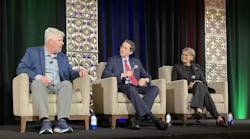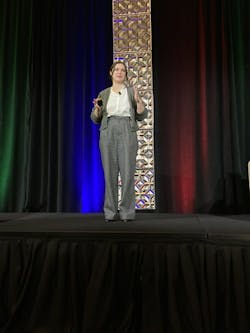The second-day keynote of the annual ARC Industry Forum 2024 focused on sustainability and commercializing the energy transition. Michael Guilfoyle, vice president of ARC Advisory, opened the session with a challenge: “Learn at least one more thing over the course of your time here, but most importantly, when you think about what you’re learning, make sure that you figure out how you can make it actionable,” he said. In that spirit, here’s a short highlight of what I learned from the keynote presentations and panel discussion.
The U.S. industrial policy
Andrew Obin, managing director at Bank of America Securities Equity Research, said, “The U.S. does now have industrial policy.” Prior to the pandemic, the U.S. spent 0.4% of its gross domestic product (GDP) on industrial policy. Now, it’s spending 2.8% of GDP, thanks largely to $1.8 trillion of stimulus in the Inflation Reduction Act. The money is designed to peak in 2026 and run through 2031, and designed to be “sticky,” Obin said. He added that, if the legislature changes leadership soon, proposed Republican cuts to the program only amount to 20%, including tax incentives, and the stimulus largely supports projects in red leaning states. Regardless of Congressional leadership, the funding should stick around, Obin predicted.
Bank of America estimates that industry will need $2.4 trillion of capex to meet net zero goals. “Reducing carbon footprint is actually very much the same as increasing efficiency. If you become more efficient, you will reduce your carbon footprint,” Obin said.
Government is also pushing carbon reduction. In March 2022, the Securities and Exchange Commission proposed rule changes requiring certain climate-related disclosures in registration statements and periodic reports, including greenhouse gas emissions, Scope 1, Scope 2 and Scope 3. “We actually think, probably given what Scope 3 means, it's probably not going to happen the way it’s envisioned just because the regulatory burden is going to be too much,” Obin said.
His outlook is positive about industry’s ability to meet the net zero goals long-term. “I think the good news for the industry is that you already make the equipment and software, and it's probably one where there will be winners and losers. But the industry makes all of these products already,” he added.
Obin’s central message: sustainability equals capex, “and the government is very much in the driver’s seat,” he said. “It’s going to happen this decade, whether you like it or not.”
Where is government driving?
Next up for the keynote was someone with some insight into governmental industrial policy and government plans to help industry decarbonize. Katheryn Scott, market, analysis engineer, U.S. Department of Energy, Office of Energy Transitions, was very happy to hear Obin’s report on the government funding sticking around long-term.
“We are working so hard every day at the Department of Energy [DOE] to get those subsidies started and rolling, and that's really what I'm here to talk about is the plan that we've been creating, of how to use these subsidies to decarbonize the industry,” Scott said. While DOE has billions of dollars of grants, cost shares and loan guarantees, net zero goals will take trillions of dollars, and it will need private-sector industry support.
“We've been really scrappy at the Department of Energy and thought about this as a government enabled, but private sector led energy transition,” Scott said. She is part of DOE team that is leading this transition, researching the technologies available and what’s needed, and talking with industry about how they want to tackle decarbonization.
In addition to the money available, DOE has released, “Pathways to Commercial Liftoff: Industrial Decarbonization," focused on eight industrial sectors: chemicals, refining, iron and steel, food and beverage, pulp and paper, cement, aluminum and glass. The report considers technologies for energy efficiency, industrial electrification, low-carbon energy, such as alternative feedstock, electrolytic hydrogen, and clean, on-site power, carbon capture utilization and storage (CCUS). “There are technologies ready in every sector,” Scott said. “These are deployable technologies that are ready to be commercialized, and they have net positive economics, so we define that as above a 10% rate of return.”
She does acknowledge the challenges for industry: market readiness, adoption rates, high delivery cost, and complex adoption. But DOE is stepping up – it has $90 billion worth of grants and cost share programs and $6 billion of industrial demonstrations that will be awarded in the next few months. “Section 48C” tax credits also are available for investment in advanced energy projects; DOE just closed its first round of $2.5 million, and another $2.5 million will be available later this year, Scott said.
“I think there's an opportunity here for United States businesses to take decarbonization and emissions reduction and put their companies in the driver's seat,” she added.
Panel discussion: sustainability starts at home
Billy Bardin, director, global climate transition at Dow Inc., and Nathalie Marcotte, senior vice president at Schneider Electric, both outlined how their companies have long been working on their own sustainability goals in prelude to helping their customers do the same. It was clear that sustainability starts from the top-down, and company success depends on executive leadership dedicated to a net-zero future.
Dow will start work on a $6.5 billion net-zero ethylene cracker and derivatives facility at Fort Saskatchewan in Alberta, Canada, decarbonizing 20% of Dow’s global ethylene capacity.
Schneider Electric started on its sustainability journey 10 years ago with its own digital transformation of its manufacturing facilities around the world. Making sustainability and digital transformation synonymous were key for advancing both missions, Marcotte said.
“We do have strong leadership support in our company, both from our CEO, executive leadership, as well as our board of directors. We see increasing demand from our investor community, from our customers and clients that decarbonization is important,” Bardin said. “There is a way to do this profitably.” Dow has demonstrated this with the strong business model and economics around its net-zero facility.
“We’ve implemented a governance structure within the company that established a climate steering team, which is basically accountable to our CEO. That’s our senior leadership team, and underneath that climate steering team, we have program management offices that are accountable for executing our climate transition work, whether that’s Scope 1 or Scope 2 reductions, Scope 3 reductions, working on how we monetize the carbon reductions that are generated or looking at our metric systems and reporting areas that have a lot to do with the digital/data side of the architecture,” Bardin said.
“You cannot control what you cannot measure. You need to put the foundation on the data aspect, so you’ve got all your data. For us and digital transformation, it seems a lot of people move from digital transformation to sustainability,” Marcotte said. “We built this digital transformation consultancy, which works closely with our sustainability organization.”


